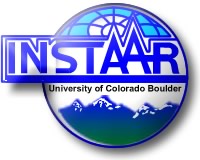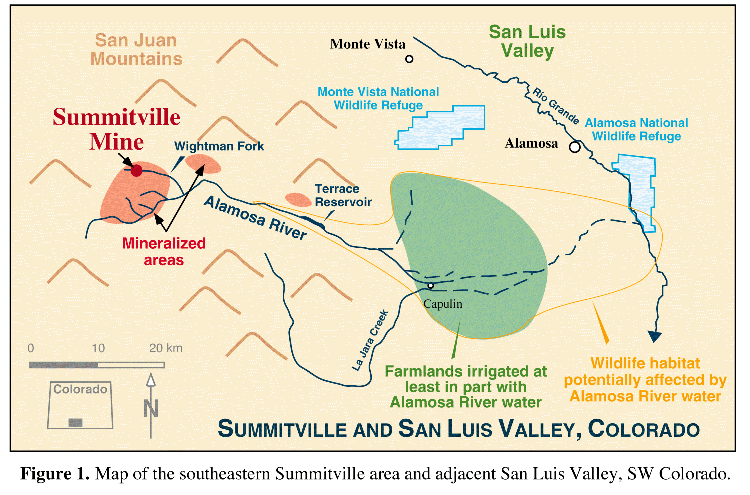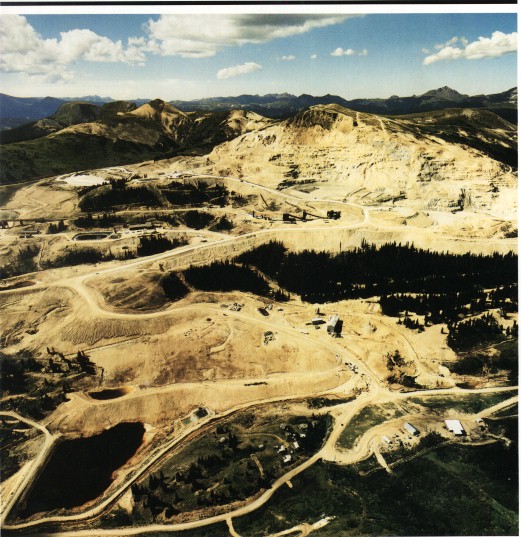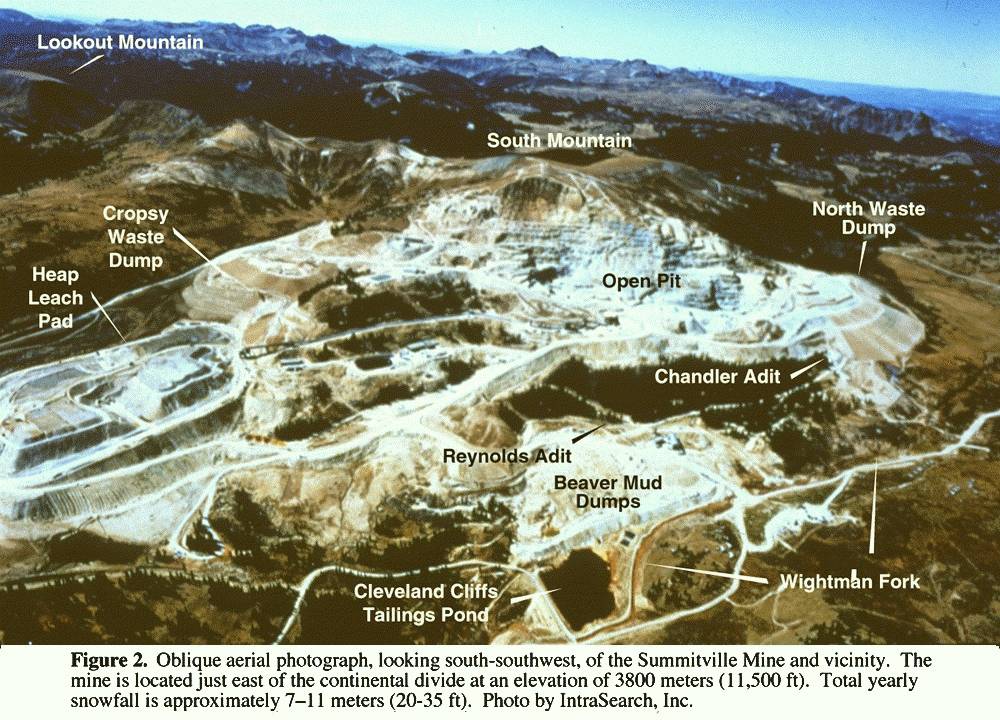 Landscapes and Water (GEOG 1011): Summitville Mine Disaster
Landscapes and Water (GEOG 1011): Summitville Mine Disaster
 Landscapes and Water (GEOG 1011): Summitville Mine Disaster
Landscapes and Water (GEOG 1011): Summitville Mine Disaster

The Summitville gold mine, located at ~3800 meters (12,800 ft) elevation in the San Juan Mountains of southwestern Colorado, was the focus of extensive public attention in 1992 and 1993 for environmental problems stemming from recent open-pit mining activities. Summitville catalyzed national debates about the environmental effects of modern mining activities, and became the focus of arguments for proposed revisions to the 1872 Mining Law governing mining activities on public lands.


Aerial view of the Summitville Mine
Summitville stats
Gold was first discovered at Summitville in 1870. Significant gold production from underground workings occurred prior to 1900. In 1903, the Reynolds adit was driven to drain the underground workings and serve as an ore haulage tunnel. Production occurred sporadically through the 1950's. The district received some exploration attention in the 1970's as a copper prospect, but no mining for copper was pursued.
Similar to many historic gold mining districts in the western United States, Summitville received renewed interest in the early 1980's due to technological advances that allow extraction of low-grade ores with cyanide heap leach techniques. In 1984, Summitville Consolidated Mining Company, Inc. (SCMCI), initiated open pit mining of gold ore from rocks surrounding the historic underground workings, where gold concentrations had been too low to be economic for the underground mining operations. Ore from the pit was crushed and placed on a heap leach pad overlying a protective liner. Cyanide solutions were sprinkled onto the heap and trickled down through the crushed ore, dissolving the gold. The processing solutions were then collected from the base of the heap leach pile, and the gold was chemically extracted from the solutions.

1984
1985
1986
1987-1990
1991
1992
1992
Today
Aspen Times Article, 1996

In the San Luis Valley, cyanide and heavy metals from the Summitville mine disaster have killed fish and other aquatic life 17 miles downstream. Farmers have reported water quality problems on land irrigated by the Alamosa River. Cleanup costs are over $85 million to date (already $25 million over the 1995 estimate) and are projected to reach $165 million by 1999.
Who pays for this continual financial hemorrhage? Until now, the polluter pays -- the company responsible for dumping the toxic chemicals. That's the law under the existing federal Superfund law. But if the chemical and insurance industries and their allies in Congress, such as the mining industry, have their way, the law will change and states and communities around the country will get struck with these environmental and financial messes.
Companies responsible for dumping their chemical waste all over America have resisted owning up to their financial liability, or the damage to the health and safety of citizens their dumping has caused. Rather than taking responsibility for the mess they created in the first place, big polluters and their insurers are lobbying Congress to let them off the hook. By having Congress weaken health protections and limit their liability, these wealthy corporations will successfully shift the costs, uncertainties and risks of cleaning up toxic-waste sites onto the backs of the American public.
Bills to "reform" Superfund have been introduced by Congressman Michael Oxley(R-OH) and Senator Robert Smith(R-NH).
Both proposals would achieve polluters' two major goals: gut the polluter pays principle of Superfund, and weaken the cleanup requirements at contaminated sites. Both bills would eliminate liability for entire classes of polluters, including many of the wealthiest corporations in America. While the federal budget is being slashed, at the expense of public health and environmental protections, the Oxley and Smith bills provide polluters with relief at the public's expense.
It is no coincidence that a recent Citizen Action analysis of PAC contributions found that corporations which would benefit from gutting Superfund, including GE, Exxon and ASARCO, gave nearly $6.5 million to members of the House of Representatives during 1995. Now they expect to recoup their investment.
Representatives Wayne Allard and Scott McInnis from Colorado accepted $47,216 collectively from these PACs. This is especially troubling since Colorado has some 225 sites contaminated by hazardous substance, including 17 that are considered among the worst in the nation, including the Summitville mine poison pit.
The House and Senate bills call for the use of the "most cost-effective" (cheapest) methods of cleaning up dumpsites. But in many instances what counts as a "cleanup" is simply preventing the public from using the land or drinking the water. Although that may be cost-effective for the polluters, it's a bad deal for the community. In many instances, a "cleanup" will mean simply fencing off a contaminated site and handing out bottled water to the nearby residents.
In addition, the bills in Congress will make it difficult, if not impossible, for the public to recover for damages to natural resources like groundwater, wilderness, fish and wildlife, endangered species and oceans. This is a huge giveaway to a handful of chemical, oil, and mining companies who will save hundreds of millions of dollars avoiding environmental restoration.
"Reforming" Superfund in these ways would send a clear message to the American public: What matters most to Congress is the wealth of the chemical, mining, and oil industries and their insurers, not the health of communities. It seems that the top legislative priority is to protect corporate profits rather than the property or drinking-water supplies of the millions of people unlucky enough to live near a Superfund site.
The polluter lobby claims that the Superfund program has been too "costly," particularly because of lawyers' fees. This is little more than a carefully contrived smokescreen. In fact, the majority of legal costs incurred by complaining corporations have been from legal battles with their own insurance companies or other polluters over who should have to pay the cleanup bills.
Sure, the Superfund program has its problems -- too much delay, not enough public participation -- but the solution is to streamline Superfund, not gut it. It should be easier for the polluters to pay for safe and effective cleanups, not harder.
Representatives Allard and McInnis will help decide if these bailout bills for polluters and insurers will pass the House or Senate. Polls consistently show that most Americans oppose weakening our environmental and public health laws. Will our representatives listen to the people, or the special interests?
Will the polluters pay for timely, thorough Superfund cleanups, or will the public "pay" for slower and less effective cleanups?
We'll soon find out.
Carmi McLean and Scott Ingvoldstad are policy analysts for the Clean Water Action organization, headquartered in Washington, D.C., and with an office in Boulder.
 |
 |
 |
 |
 |
|
aspen snowmass online |
subscribe | letters to the editor |
comments | index |
Send responses to info@aspen.com
Copyright © 1995 Aspen Interactive Media, Inc. and The Aspen Times